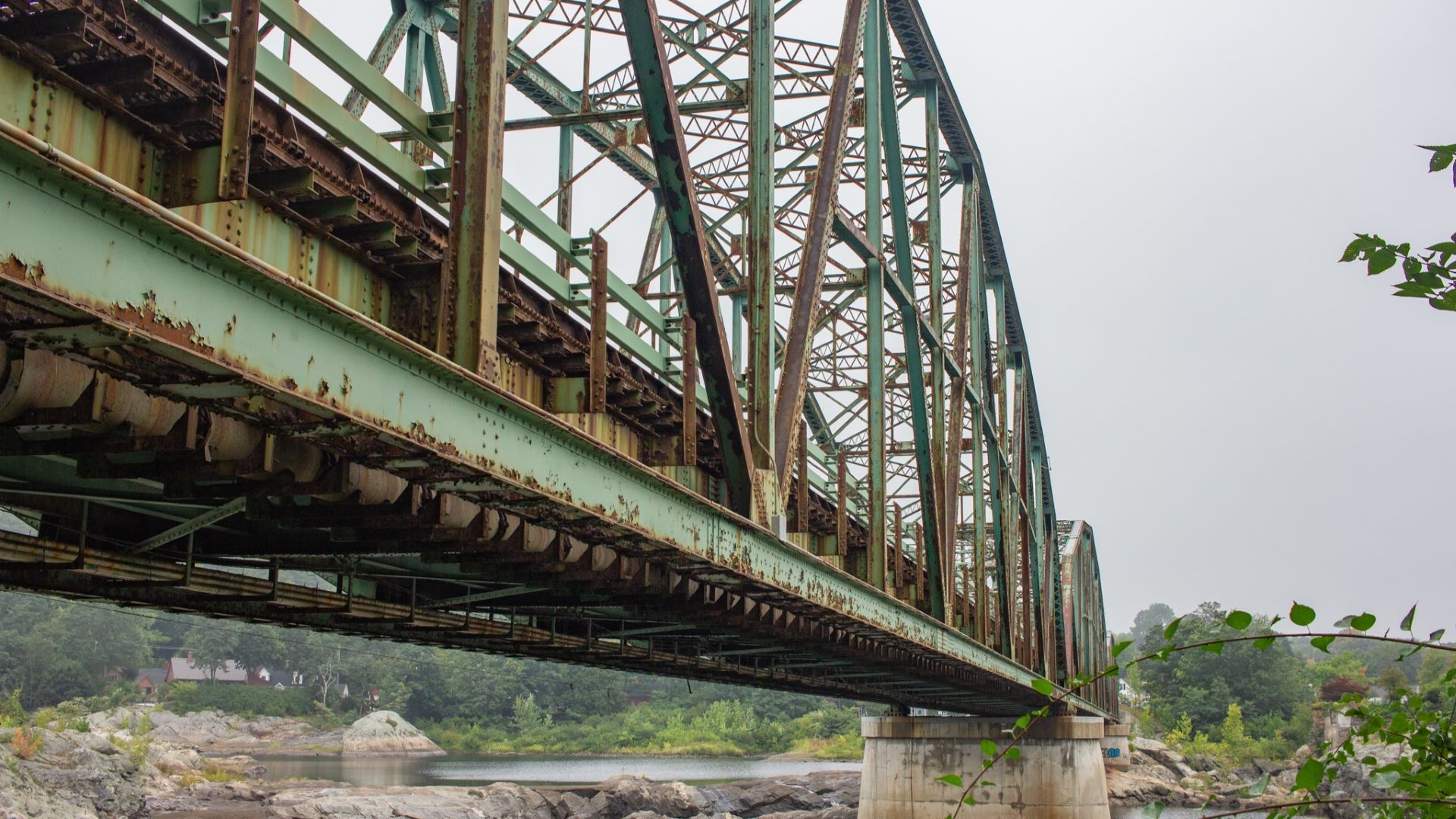Sign up here for one of The Maine Monitor’s free newsletters.
For 91 years, the Frank J. Wood Bridge has spanned the Androscoggin River between Brunswick and Topsham, carrying 19,000 vehicles daily between the two towns. But after decades of poor maintenance, it’s visibly rusty, dangerously corroded and at risk of collapse.
In 2016, the Maine Department of Transportation (MDOT) proposed building a replacement bridge just upstream, which the department and many residents continue to argue is essential from a safety standpoint. But seven years later, the Frank J. Wood Bridge still stands — and the cost estimate to tear it down and replace it has grown by some $35 million.
The delays are due to the work of 10 local residents who have devoted thousands of hours and roughly $130,000 toward protecting the bridge. The group, the Friends of the Frank J. Wood Bridge, argues that replacing the bridge is not just an affront to an iconic and historic landmark, but federally illegal.
“It’s like driving through a sculpture,” said Arlene Morris, a Brunswick artist and resident among those fighting for the bridge’s preservation. “It’s unique. It’s between the two mills, and it just has a beauty that I guess people don’t appreciate.”
The Friends are fighting an uphill battle. In February, after four years of litigation, federal authorities approved the state’s plan to tear down and replace the bridge. On March 28, MDOT accepted a $50 million bid to complete the project, and construction is planned to start later this spring.
“(The bridge) is endangering public safety and welfare, and it’s also an inconvenience. A lot of people are avoiding it,” said Sally Costello, Brunswick’s director of economic and community development. “It’s continuing to deteriorate. The Friends of the Frank J. Wood Bridge continues to not give up … The First Circuit Court and the Federal Highway Administration confirmed that (replacing) it needs to be done.”
The saga represents a broader theme: just how much power one small group’s refusal to budge can have in the face of seemingly inevitable change. Just 10 citizens, who believe they have the law on their side, have fended off the best efforts of the state’s third-highest-funded agency and overwhelming public opposition. Safety has been pitted against preservation, public consensus against individual persistence and the state of Maine against 10 headstrong citizens.

In response to MDOT accepting a construction bid last month, the Friends filed another lawsuit, seeking to stop the process with a last-ditch court order. The group acknowledges that if this suit fails, the fight might be over.
There’s only one thing everyone can agree on: The Frank J. Wood Bridge is falling apart. Maintenance surveys have repeatedly shown dangerous levels of corrosion to the beams that support the asphalt deck of the bridge.
“I have anecdotes from constituents … people who feel the need to roll their windows down when they cross the bridge, just in case (it collapses),” said Topsham Select Board member Matthew Nixon. “Some people have flat-out refused to even cross the bridge.”
“I do not drive across that bridge anymore. I don’t believe it’s safe,” said Dennis Tefft, a retired kitchen designer from Brunswick. “I’ve actually been down under the bridge, and it doesn’t look very good.”
In 2015, MDOT held a public meeting with Brunswick and Topsham residents to weigh in on potential solutions. A year later, MDOT held another meeting where it announced it planned to tear down the bridge and build a replacement. A few participants left that meeting feeling ignored.
“They had not done the preliminary design, and there was no mention of any review process or federal laws or anything,” said John Graham, a Topsham real estate broker and president of Friends of the Frank J. Wood Bridge. “A bunch of us stood up and said, ‘We’ve got to do something.’ We took some names down, and we were meeting the next week.”
WATCH: A behind-the-scenes look at construction of Portland bridge
That group, which has organized into a registered nonprofit, has met regularly ever since. Most of the time it gathers in the dining room of members Steve Stern and Arlene Morris’ Brunswick home. The Friends, composed entirely of local residents, have backgrounds in fields that include civil engineering, historic preservation, art, organizing and real estate. They’ve come together as often as weekly to coordinate legal action and messaging.
It’s a lot of work. There are tens of thousands of pages freedom of information records to comb through, newspaper op-eds to write and documents to file. It’s been demanding, especially for Graham, its president.
“It seems like a lot of work for everyone, but especially for (Graham),” said Morris, an artist with a Topsham studio. “It’s a lot of time, and he’s got four kids and a full-time business. He’s risking his entire existence.”
The financial burden has also been high. Aside from paying for advertising and independent engineering counsel, the main expenses have been lawyers’ fees, which have approached $100,000. Fundraising has helped, but Graham said almost all the money has come from the members. Stern, a retired doctor and civil engineer, and Morris said they contributed a large chunk from their retirement fund. Graham has forked over “more than (he) wanted to.”
The Friends’ persistence hasn’t earned them much popularity around town. Critics say if they hadn’t held up the process for so long, the new bridge would have been finished years ago.
“I don’t know why it hasn’t been replaced by now,” said Robert Cecil, a retired teacher from Topsham. “By the time we finally get around to getting a new bridge, this delay will increase the price of it immeasurably.”
Starting construction in 2016 would have saved taxpayers millions because materials and labor prices have risen due to inflation. And ongoing surveys show the bridge continues to deteriorate: The state has lowered its weight limit to a point where fire trucks, school buses and commercial vehicles are banned from crossing.
“Clearly, prohibiting commercial traffic is a serious problem for economic development purposes,” said Nixon, the Topsham Select Board member. “It has been a hindrance for a wide variety of sectors in both towns, whether it’s education, commercial or public safety.”
The Friends have faced public hostility. Large signs reading “Save the Frank J. Wood Bridge,” placed on both banks of the Androscoggin, were vandalized and stolen in June 2021. Graham regularly deletes harsh, often expletive-laced comments on the group’s Facebook page.
“My wife wants to do an exhibit with all the nasty comments,” said Graham. “(They say) we’re baby killers. We’re going to kill people. We’re idiots. We cost taxpayers money. I don’t pay any attention to it.”
Stern put it more simply: “They hate us.”
Why keep going? The Frank J. Wood Bridge isn’t altogether unique; there are hundreds of other bridges of similar construction and vintage across the nation. By this point, public opinion firmly favors replacement: Both the Brunswick Town Council and Topsham Select Board passed resolutions supporting the new bridge last month.
The bridge, built by Boston Bridge Works in 1932, is one of the 30 remaining historic truss bridges in the state. That number has fallen; MDOT has overseen the replacement of 47 similarly built truss bridges since 1999. The Friends say the bridge is a landmark that features prominently on advertising and promotional content for Brunswick and Topsham, as well as Bowdoin College.
More importantly, there is a legal argument for its preservation. Because of the bridge’s historically protected status, to tear it down, federal law mandates that state authorities must prove that the cost of rehabilitating and maintaining the structure would be significantly higher than building a replacement.
That was the basis of the group’s first lawsuit in 2019, which only ended in February. After an appellate hearing in 2021, a federal court directed MDOT to recalculate its cost estimates, which the Friends claimed were fraudulent and based on incorrect accounting methods. This February, the Federal Highway Administration determined that because updated cost estimates showed it would cost an additional $10 million to rehabilitate the current bridge compared to replacing it, a 53 percent difference, approval was given to tear it down.
WATCH: Inside (literally) the Penobscot Narrows Bridge and Observatory
Now, with MDOT set to start construction, the Friends have filed for an injunction to stop the process. Federal authorities decided to allow MDOT to tear the bridge down based on the 2017 cost estimates, which said it would cost $13 million to replace the bridge. But last month, when MDOT accepted a final construction bid from Reed & Reed of Woolwich, it came in at just under $50 million.
MDOT did release another, more recent estimate of $42 million to replace the bridge last August. But the legal decision permitting it to replace the bridge was based only on the $13 million estimate.
The Friends are crying foul. They accuse MDOT of knowingly underestimating the price to push the project through, and argue that inflation alone can’t explain almost a fourfold price increase. The Friends argue that replacing the bridge without full due diligence, including a review of the updated costs, would be illegal and set a dangerous nationwide precedent.
”We’ve been saying it for six years now. You can’t build a (new) bridge for $13 million. You never could,” said Graham. “The bid came out at $50 million … What’s the point of the law if you can say it’s going to cost $13 million? It’s a precedent that’s going to affect everything in this country, from bridges to parks.”
The Friends are backed up by their legal counsel, which includes Andrea Ferster, a leading historic preservation lawyer in Washington, D.C.
“Fundamentally, it has to do with whether agencies can just make things up,” said Ferster. “When an agency just ignores new information and uses numbers that are irrefutably wrong, that really tests the limits of agency discretion … At what point is there any accountability?”
In response to a question about the lawsuit, a MDOT spokesperson wrote, “We are moving forward to deliver a new bridge for the people of Brunswick, Topsham, and the surrounding communities. The new bridge will be safe, reliable, and serve all users well, including motorists, pedestrians, and bicyclists.”
The new suit claims that federal law requires agencies to update their cost estimates every three years if there have been significant changes. But as construction begins, the Friends and their lawyers are fighting against time.
“If the court goes against us here, we’ve probably lost,” said Graham. “Once something’s moving, it’s really tough to pull it back.”








